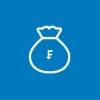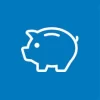The climbing key interest rates are finally making a difference in Swiss savings accounts. Adults can currently benefit from standard interest rates of up to 0.65 percent – with higher interest rates from savings accounts with bonuses or tiers. Across all offers, the weighted average in January 2023 is 0.19 percent interest per annum. That is more than four times higher than it was one year ago, when the average interest rate was 0.04 percent.
“For conservative savers, that news is a welcome introduction to the new year,” says moneyland.ch CEO Benjamin Manz. In total, ten of the adult savings accounts included in the moneyland.ch comparison (including investment savings accounts and tiered savings accounts) have a standard interest rate of at least half a percent (see table 1).
Table 1: Savings accounts with 0.5 percent interest per annum or higher
| Service provider |
Account |
Interest rate for the first year |
| Zuger Kantonalbank |
Savings Account Plus |
0.65% |
| Luzerner Kantonalbank |
Savings account |
0.60% |
| Schaffhauser Kantonalbank |
Plus savings account |
0.60% |
| Clientis Spar- und Leihkasse Thayngen |
Top savings account |
0.55% |
| Clientis BS Bank Schaffhausen |
Top savings account |
0.50% |
| Crédit Agricole next bank |
Energy savings account |
0.50% |
| Glarner Kantonalbank |
Savings account |
0.50% |
| Schaffhauser Kantonalbank |
Savings account |
0.50% |
| Yuh |
Savings |
0.50% |
| Zürcher Kantonalbank |
Savings account |
0.50% |
But it is important to look at the exact terms and conditions. Many of the highest-yield savings accounts have tighter limits on withdrawals, or other limitations. For example, the 0.6 percent annual interest rate of the Plus savings account from the Schaffhauser Kantonalbank only applies to the portion of your account balance which falls below 20,000 francs. Other savings accounts like the Top account from the Clientis Spar- und Leihkasse Thayngen and Clientis BS Bank Schaffhausen banks require you to give 12 months’ notice ahead of withdrawals. The Energy savings account from Crédit Agricole only lets you make penalty-free withdrawals after the first 12 months. The terms and conditions of savings accounts are shown in the moneyland.ch savings account comparison.
The best savings interest rates come with special requirements
The banks which offer the current best interest have special requirements which you must meet in order to get the highest possible interest rates. These are not accounted for in the table above (table 1). For example, only Bank WIR Bonus savings account holders who also own Bank WIR shares enjoy the special higher interest rate. Customers who are willing to invest in Bank WIR shares benefit from an interest rate of 0.85 percent per annum, plus an additional 0.35 percent bonus for new money.
Also among the best savings accounts in the first year is Bank Cler's Savings Account Plus, where in addition to the interest rate of 0.3 percent, there is a one-time new money bonus in the amount of 1 percent for newly deposited funds into the account. This bonus is valid for one year from the date of account opening. After the end of the first year, however, the interest bonus on net new money is paid only until the end of the respective calendar year. These kinds of bonuses are also accounted for in the moneyland.ch savings account comparison.
The biggest banks have lower interest rates
Of the five largest Swiss banks (table 2), the Zürcher Kantonalbank is the most generous, with 0.5 percent interest per annum. Postfinance’s 0.4 percent interest rate is also more than twice as high as the national average. UBS savings accounts, on the other hand, still pay no interest at all. Credit Suisse and Raiffeisen Switzerland have also remained rather miserly, offering interest at rates well below the average.
“In terms of interest, the biggest Swiss banks are often a worse deal than smaller banks,” observes Manz. The reason: Attracting new customers is often less important for bigger banks, and that is why they tend to have less favorable conditions.
Table 2: Savings accounts from the biggest Swiss banks
| Service provider |
Account |
Interest rate for the first year |
| UBS |
Savings account CHF |
0.00% |
| Credit Suisse |
Savings account |
0.01% |
| Raiffeisen Schweiz (recommended rate) |
Savings account |
0.10% |
| Zürcher Kantonalbank |
Savings account |
0.50% |
| Postfinance |
Savings account |
0.40% |
More than 1 percent interest per annum for young people
Youth savings accounts, which generally have much higher interest rates than standard savings accounts, have also seen hikes in interest rates – albeit smaller than those of standard savings accounts for adults. On average, teenagers and young adults currently earn interest at the rate of 0.52 percent per year. A month ago, the average rate was 0.42 percent. Many private accounts for young people also have significantly better interest rates than standard offers.
Table 3: Youth savings accounts with 0.75 percent interest or more
| Service provider |
Account |
Interest rate for the first year |
| Banca Stato |
Giovane savings account |
1% |
| Luzerner Kantonalbank |
Blu savings account |
0.80% |
| Berner Kantonalbank |
Youth savings account |
0.75% |
| Postfinance |
Youth savings account |
0.75% |
| Clientis Bank Aareland |
Mymix savings account |
0.75% |
| Bank Avera |
Sparkonto 25 savings account |
0.75% |
| Ersparniskasse Schaffhausen |
Sparkonto 25 savings account |
0.75% |
| Glarner Kantonalbank |
Youth savings account |
0.75% |
| Leihkasse Stammheim |
Sparkonto 25 savings account |
0.75% |
| Zuger Kantonalbank |
Youth savings account |
0.75% |
| Zürcher Kantonalbank |
Youth savings account |
0.75% |
Of the biggest Swiss banks, the Zürcher Kantonalbank and Postfinance also take the lead in terms of interest paid on youth account balances. Raiffeisen Switzerland, with its 0.5-percent annual interest rate, falls just under the Swiss average. The special interest rates for youth accounts, which are high compared to those of standard accounts, are paid out to customers until they reach a certain age. Age limits vary between service providers, but typically range between 18 and 25 years old. Only a few banks have higher age limits.
Who should use savings accounts at this point in time?
Is using savings accounts worth it now that interest rates are going up? “Even with the higher interest rates, you still do not earn enough interest to make a real profit,” explains Manz. “Because of the current Swiss inflation rate of nearly three percent, even the current highest-yield savings accounts do not deliver a real return.” That applies to both standard savings accounts and to youth offers.
But that does not mean that savings accounts are useless, clarifies the expert. “Savings accounts continue to be suitable for people who want to invest their money with little risk and do not want to tie up their money for many years. In this case, earning more interest is still better than nothing.”
Euro savings accounts are now less attractive
The key interest rate for the euro is currently more than twice as high as that of the Swiss franc. However, the interest rates of euro savings accounts are not increasing faster than those of Swiss franc accounts. The current highest interest rate for a Swiss euro-denominated savings account is 0.75 percent, and is offered by the Schaffhauser Kantonalbank. “That is not much more interest than you could earn from a franc-denominated savings account. As long as inflation rates in the Eurozone remain much higher than that of Switzerland, using euro savings accounts is hardly worth it,” concludes Manz. Additionally, there is the risk of losing money if the euro falls against the franc.
More on this topic:
Compare Swiss savings account interest rates using the interactive comparison





